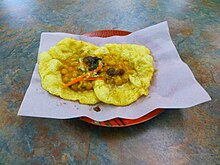Trinidad and Tobago cuisine
[1] Popular breakfast foods include doubles, made with two baras (flat fried dough) and curried channa (chickpeas).
[2][3] A traditional Indo-Trinidadian and Tobagonian breakfast consists of sada roti, a type of unleavened bread made with flour, baking powder and water.
Other common dishes include aloo chokha (boiled, roasted, and mashed potatoes), karaili chokha (roasted and mashed bittermelon) and murtani or upar ghar (combination of roasted and mashed eggplant, tomato, pepper, and okra); fried or curried bodi (long beans), aloo (potatoes), ochro/bhindhi (okra), seim (hyacinth beans); fried or curried karaili (bittermelon), saijan (drumstick) and lauki (bottle gourd), pumpkin or kohra tarkari (pumpkin simmered with spices and seasoning); and bhaji (made with young dasheen bush (taro) leaves, spinach leaves, saijan (drumstick) leaves, or chaurai (spiny amaranth) leaves), and/or fried plantains.
[18] Tobago is also known for its sumptuously prepared provisions, such as dasheen (taro root), sweet potato, eddoe, cassava, yam, soups and stews, also known as blue food across the country.
The murtanie (mother-in-law) is another popular condiment which is a coarsely chopped spicy medley of scotch bonnet peppers, carrots, karaili (bitter melon) and other spices.
Chutneys are popular as well and often include chaltar (dillenia indica), mango, tamarind, cucumber, pommecythère, bandhaniya, dhaniya, tomato, and coconut.
Along with pows (Cantonese steamed buns filled with meat, typically char siu pork), fish, cheese and beef pies.
On festive occasions (Carnival, Borough Day and most public holidays), street foods also include wild meat such as deer, iguana, manicou (phalangeriformes), tatou (armadillo), and agouti, to name a few.
Special Christmas foods include appetisers like pastelles (called hallaca in Venezuela where they originated), pholourie, saheena, baiganee, kachori, and chicken or pork pies.
Drinks include coconut water, ginger beer, ponche crema, egg nog, cocoa tea, and sorrel.
Desserts include mohan bhog (parsad), lapsi and suhari, burfi, khurma, gulab jamun, pera, rasgulla, batasa, gujiya, gulgula, roat, kheer (sweet rice), laddu, and jalebi.
Along with that Indian delicacies like kheer (sweet rice or meetha bhat), sawiyan, khurma, gulab jamoon, laddu, jalebi, halwa, mohan bhog (parsad) and lapsi.
As in local soft drinks [sodas] (Chubby's, Busta, LLB (Lemon Lime and Bitters), Solo, Peardrax,[32]), maltas, shandies, citrus juices and ginger beers.
Along with the chenette (Melicoccus bijugatus), pineapples, oranges, portugal (tangerines), plums, bananas, barbadine, balatá, soursop, cashews, tamarind, ceres (Flacourtia indica), pois doux, cocorite (Attalea maripa), gru-gru-beff (Acrocomia aculeata), fat-pork (Chrysobalanus icaco), pears, and coconuts.
The main ingredients of chow are usually: the fruit of choice, culantro (bandhaniya), pepper (powdered, sauce or natural form), salt and sometimes garlic and vinegar.
Traditionally, the most popular fruits for chow have been mangoes, pommeracs, pommecythère, cucumbers, tomatoes, portugals, sour oranges, salted prunes, cherries, pineapples, green apples, pears, and plums.









